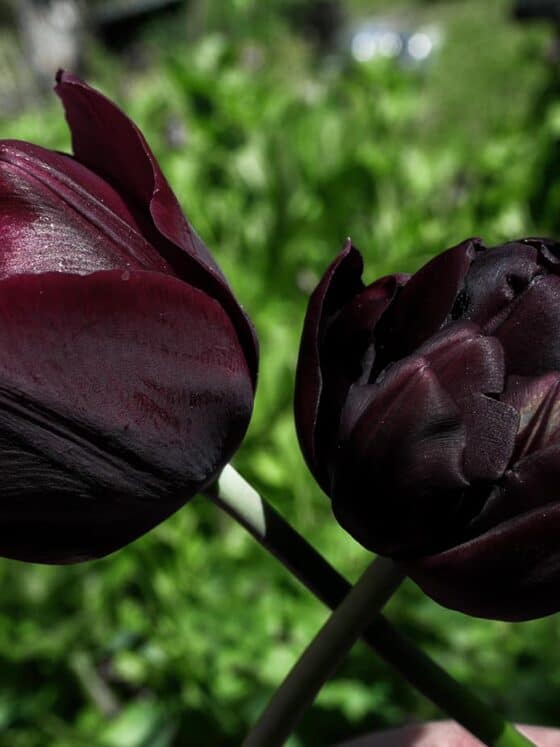Do black roses exist? When I first embarked on my journey to create a black-themed garden, the idea of black roses intrigued me. Were they even real, or just a goth gardener's myth? Turns out, these dark beauties do exist - well, at least in certain light - and they bring an otherworldly charm to any garden. In this guide, I'll share my personal tips and tricks on how to care for black roses so that even Edgar Allan Poe would envy!
Roses are the undeniable divas of any garden, commanding attention with their beauty and elegance. But if you really want to up the drama, why not introduce black roses into the mix? There is some nice number of black rose varieties, and their deep, velvety petals add a touch of mystery and sophistication that transforms any garden into a stunning, gothic wonderland.
ARE BLACK ROSES REAL?
Yes, black roses do exist in theory, just like other black flowers. These dark flowers are not truly black, but rather appear to be black due to their extremely deep and intense color, especially under low lighting conditions. Sometimes, the rose’s color is enhanced by placing it in a vase with black food coloring. (Gardentabs)
These dark roses, which range from deep maroon to nearly black hues, are often the result of specific breeding techniques. Among the most notable dark roses are ‘Black Baccara,’ cherished for its velvety petals with a rich burgundy tone that darkens as the flower matures. I also have personal experience on ‘Barkarole,’ which displays a stunningly deep red that can appear nearly black under certain lighting. Barkarole is something I could recommend to any vampire fans because the color is simply just so deep and delicious!
Please note that Black rose is also a succulent plant, also known as Black Tree Aeonium, Purple Crest Aeonium, Black Beauty, Dark Purple Houseleek. At this point I have more experience on actual roses, but if you came here looking for advice about this succulent plant black rose, check out this guide on How to Grow and Care for Black Roses.
A list of black rose varieties (or, at least the darkest divas!)
Black Baccara
The Black Baccara rose is a hybrid tea rose with velvety petals that appear nearly black in low light, ranging from deep red to burgundy in color. This rose is probably the most famous of all the dark goth roses. It was developed by Jacques Mouchotte and introduced by Meilland International in 2000 (Wikipedia) (Regan Nursery) (Gardening brain).
Black Beauty
The Black Beauty rose earns its name from its deep black buds, which unfurl into stunning crimson blooms with striking black tips on the petals. Growing upright to heights of 3 to 4 feet, this hybrid tea rose adds drama and elegance to any garden. Throughout the blooming season from spring to fall, it showcases large, velvety flowers against a backdrop of dark green, glossy foliage. According to David Austin Roses it’s perhaps not the most reliable variety, but the color is indeed wonderful. (David Austin Roses) (HelpMeFind)
Black Magic
The Black Magic rose, credited to Hans Jurgen Evers in 1995, is a hybrid tea rose that produces deep red blooms with a dark, almost black, appearance. It is popular in gardens and as a cut flower due to its striking color and form. Hardy in zones 7-10. (Emundi roses).
Barkarole
Barkarole was my first dark rose. It is another hybrid tea rose with very dark red petals that can appear almost black. The flowers are velvety red, and at least mine has this red-to-black gradient-like coloring that creates a beautiful vampiric special effect. What is especially exquisite with this rose is that the new leaves are dark red. They will later turn cold, dark green (EastcroftRoses).
Black Jade
Black Jade is a charming miniature rose variety known for its upright growth habit and glossy, dark green leaves. This petite rose reaches only about 2 feet tall and produces very dark red, almost black flowers from spring to fall. It thrives in containers, rock gardens, and small spaces, making it ideal for the front of beds and borders. Black Jade prefers an open site in full sun and moderately fertile, humus-rich, moist but well-drained soil. (FineGardening)
Night Owl
Night Owl is a climbing rose with dark purple flowers that can appear nearly black in certain lights. This rose is known for its vigorous growth and large clusters of semi-double flowers that have a lovely and unusual apple fragrance. (The Fragrant Rose Company).
Midnight Blue
Midnight Blue, also known as Black Ice, is a shrub rose with deep dark purple petals. No, not quite blue, but dark enough to be on this list. Midnight Blue was bred in the US by Tom Carruth in 2004, meaning that it’s also quite new. It is also known for its strong spicy clove fragrance and abundant blooms throughout the growing season (Minneopa Orchards) (WikiHow).
Fun fact. I first typed “spicy glove fragrance”. Yeah. English isn’t my first language…
Black Beauty
Black Beauty is a rose cultivar with very dark red blooms that have a blackish hue, especially at the edges of the petals. This rose is noted for its striking color and is often used in dramatic floral arrangements (Gardening Brain).
Black Velvet
Black Velvet, another hybrid tea rose, boasts deep red to maroon petals. Black Velvet is also known as Rosa Tuscany, Old Tuscan, Black Tuscany, and The Old Velvet Rose. This rose variety is valued for its rich color and velvety texture (HelpMeFind) (Gardentabs) (David Austin Roses) (Emundiroses). I haven’t seem them in nature, but to be honest, in pictures they seem a bit too purple-red to my personal taste.
Black Pearl:
The Black Pearl Rose is a captivating hybrid tea rose with velvety, darkest red blooms. Bred from ‘Papa Meilland’ and with intricate parentage from seven other rose varieties, it produces large, perfectly formed, fully double flowers. The unopened buds appear almost black, and when they open, they reveal a deep, glowing velvet-red color. (Heirloom roses) (Ludwig’s roses).
Dark Night
Dark Night, also known as Black Gold, Dark Knight, is a peculiar, interesting option. It’s not fully black, but instead, the petals are bicolored. They feature a combination of deep velvety red on the inside and a contrasting golden yellow on the outside, creating a dramatic and eye-catching effect. Dark Night is a hybrid tea rose, bred by Alain Meilland, and grows up to 120-180 cm (4-6 ft) tall. (Gardenia) (Star Roses)
—
*Hybrid tea rose means that the rose grows long, sturdy stems with one blooming rose to them. These roses produce flowers on long, sturdy stems, making them ideal for cutting and floral arrangements. The long stems also provide a striking vertical element in garden displays. Unlike some older rose varieties that only bloom once a season, hybrid tea roses are known for their ability to bloom repeatedly throughout the growing season.
CHOOSING THE RIGHT ENVIRONMENT
Selecting the Perfect Soil
While caring for black roses, selecting the perfect soil is crucial. These unique roses thrive in well-draining, rich soil. Look for soil mixes that contain perlite or sand to ensure good drainage, which is vital to prevent root rot. Maintaining a soil pH between 6.0 and 6.5 will ensure the roses can access the nutrients they need for optimal growth and vibrant blooms.
Watering roses – Well-draining base is important!
Proper watering is essential for the health and coloration of dark roses. Supply your roses with deep watering, focusing on the base of the plant to keep the foliage dry and minimize the risk of fungal diseases.
However, you need to allow the soil to dry before watering again; roses don’t like to have their roos soaked all the time. When planting roses, proper drainage is important to prevent excess moisture from harming the plants. You can create a proper drainage by pouring a layer of coarse sand, gravel, or small stones at the bottom of the planting hole, about 5-10 cm thick. This helps water drain away from the roots. Place a layer of filter fabric or similar material over the drainage layer to prevent soil from mixing with the drainage material.
Guess who forgot to do the filtering part with my newest black baccara… We’ll see if there’s impact. Then again, with my barkarole that I bought years ago, I didn’t even know about creating a drainage! That rose is alive but I guess it could be doing better. Yaiks! So dear darklings, remember to install a proper draining!
Fertilizing
I’m going to reveal a secret: I am terribly bad with fertilizing! I always forget to do that. But when I do remember to do it regularly, I can definitely see a difference. So, to maintain the striking dark hue of the flowers, apply a balanced fertilizer regularly during the growing season and prune the plants to encourage healthy air circulation. Remove dead or diseased wood and spent blooms. This encourages new growth and can help maintain the vibrancy of the flowers.
Providing Optimal Lighting Conditions
With black roses, providing optimal lighting conditions is key to their health and growth. These dark beauties prefer full sun to partial shade, wherein they receive at least 6 hours of sunlight daily. While too much direct, intense sunlight can sometimes fade colors, these darker varieties generally thrive with plenty of light.
Then again, extreme temperatures can affect the color of the roses. It is important to strike a balance between providing enough sunlight for the roses to thrive and avoiding excessive exposure that could harm their delicate petals. Placing them in a spot with bright, indirect light can also work well, especially in hotter climates where intense sunlight may scorch the leaves. One idea is to plant the rose to a spot where other elements like trees are filtering the light a bit.
Cooler temperatures often enhance the deep hues, so consider planting in an area that offers some protection from extreme heat.
I know. It’s hard. Have direct sunlight but not too much, but still quite a lot, and keep them still cool. At least you can use mulch around the base of your rose to help regulate soil temperature. Np: Katy Perry – Hot N Cold.
The Delicate Balance of Watering
Balance is key when it comes to watering your black roses. These mysterious beauties require consistently moist soil. Overwatering can lead to root rot, while underwatering can cause stress to the plant. Ensure the soil is well-draining to prevent waterlogged roots.
Maintaining the Ideal Humidity Level
Balance is vital when it comes to humidity levels for black roses. These dark blooms thrive in high humidity environments, around 50-60%. To maintain the ideal humidity, consider using a humidifier or placing a tray of water near the plant to increase moisture levels in the air.
Delicate care is needed to strike the right balance in humidity for black roses. Avoid excess moisture, as it can lead to fungal diseases, but ensure enough humidity to keep the plant healthy. Regular misting can also help mimic their natural habitat and promote lush, dark foliage.
Pruning and Grooming
Pruning Techniques for Healthy Growth
On the path to nurturing your Black Roses, mastering the art of pruning is necessary. Regular pruning promotes healthy growth, encourages new blooms, and maintains the desired shape of your roses.
Deadheading and Shaping Your Black Roses
Techniques for deadheading and shaping your Black Roses are crucial for their overall health and appearance. Deadheading, the process of removing spent blooms, redirects energy back into the plant for new growth. Shaping your roses by pruning helps maintain their form and structure, enhancing their beauty in your garden. This process not only benefits the aesthetic appeal of your Black Roses but also contributes to their overall health and vigor. Regular deadheading and shaping will keep your roses looking their best and thriving season after season.
COMMON PROBLEMS AND SOLUTIONS
Dealing with Pests and Diseases
Your black roses may fall victim to common garden pests like aphids or diseases such as powdery mildew. An early sign of infestation is wilting or yellowing leaves. Combat these issues by using insecticidal soap for pests or fungicide for diseases, following instructions carefully to protect your roses.
My personal opinion is that when selecting any pesticide, make sure that you aren’t using anything that stays in the ground for too long or harms other, useful bugs. You do what is must, but be mindful. First use any organic and more natural ways for minimizing any pests.
Overcoming Nutrient Deficiencies
With black roses, nutrient deficiencies can manifest as stunted growth or discolored leaves. To address this, conduct a soil test to determine lacking nutrients. Supplement the soil with a balanced fertilizer specifically formulated for roses, ensuring it includes imperative elements like nitrogen, phosphorus, and potassium to promote healthy growth. …Oh, and remember to check that pH!
To maintain the mysterious allure of your black roses, it’s crucial to address any problems they may encounter promptly.
Key Takeaways:
- Yes, “black roses” are real, but… Even flowers that seem fully black are usually actually deep red, purple or maroon-colored. A dim light will create the illusion of a black flower.
- Choose the right location: Black roses need at least 6 hours of sunlight daily to thrive. Choose a spot in your garden that receives adequate sunlight.
- Prune regularly: Keep your black roses healthy by pruning dead or diseased branches. This encourages new growth and improves air circulation.
- Use well-draining soil: Black roses prefer slightly acidic, well-draining soil. Consider amending your soil with compost to improve drainage.
- Water deeply but infrequently: Water your black roses deeply to encourage deep root growth. Allow the soil to dry out between watering to prevent root rot.
- Protect from pests: Keep an eye out for common rose pests like aphids and spider mites. Use natural remedies or insecticidal soaps to protect your black roses.
To wrap up
On the whole, tending to the enigmatic beauty of black roses requires a delicate touch and keen attention to detail. Be mindful of, the care you provide will determine the poetic allure they exude, so tend to your black roses with all the dark love and dedication they deserve.


